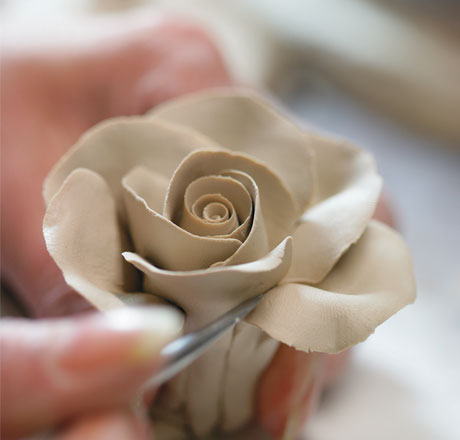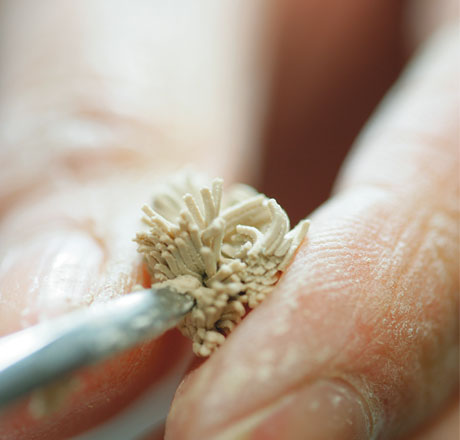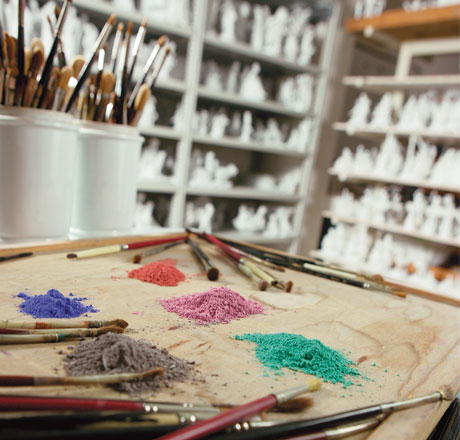Kaolin (from Kao-ling - high mountain, a region in China near King - tên - chên) is an infusible, pure white aluminium hydrosilicate which, when mixed with fusible feldspathic petuntse (white quartz - pottery stone) and subjected to a temperature of 1300 - 1400°C, forms a white nonporous, translucent, vitrified material known as porcelain. The finished product can withhold a steel point without denting.
The discovery of “red stoneware” by Böttger was the prelude to uncovering the secret of porcelain.
The composition of porcelain was discovered when, during the course of his persistent search for a clay that turned white after heating, Böttger stumbled across kaolin, which he found in great supply in Aue, in the vicinity of Meissen in Saxony.
In 1713 the first Meissen porcelain appeared in the Easter Festival in Leipzig. Despite the severe protective measurers in place, the secret of the composition of porcelain soon arrived in three other European centres: Vienna in 1719, Venice in 1720 and Doccia in 1737.It was nonetheless necessary to wait until the middle of the century before the manufacture of hard paste porcelain was widespread.

In France, where hard porcelain was not experimented with until 1768 in Sèvres, “soft” porcelain had been produced for some time. This consisted of a paste with a (cast) lime vitreous material mixed with white clay and other substances affording a near-white, opaque appearance. This was then fired at a temperature of no more than 1100°C. A lead-based glaze was then applied and cast for a second time at a lower temperature (muffle kiln).
In 18th century, whilst Germany, Austria and Italy were producing hard cast porcelain, the French factories had adopted the soft paste and continued to use it even after the production of “hard paste” had begun in Sèvres in 1768.
“Soft paste” was also worked in all the English factories with the exception of Bristol and Plymouth, and it was used for the first Zurich and Capodimonte porcelain. A mixture between soft and hard porcelain is still used in England, the composition of which includes bone-ash paste.

The porcelain paste, after having been turned on the lathe, moulded or modelled is placed to dry at a moderate heat in the kiln. The dry piece can then receive the finishing touches and is smoothed flat.
Following this, the ‘cover’ or glaze is applied, generally by means of immersion in a lead-based mixture (lead silicate, lead sulphate or lead oxide) for soft porcelain or in a feldspathic-based mixture (fusible feldspar, lime, sand or quartz) for hard porcelain.
The first type reaches the right temperature, fusing itself to the body of the porcelain, at around 1100°C; the second requires a temperature of around 1300-1400°C.

The ‘cover’ can be white, in which case the mix contains tin (solder) or coloured. The high temperatures require limit the available colours to mineral colours, which are cobalt oxide (blue), ferrous oxide (green-brown) and copper oxide (red-violet).
The ceramic piece can be white or a uniform colour and can be subsequently decorated with colours (metallic or mineral oxides) that require a lower temperature than the first firing. In order to achieve this it is placed in a “muffle” made out of a refractory material for one or more bakes on a falling scale depending on the point of fusion of the colours that are applied in layers.
The final firing, carried out at the lowest temperature, is for the gilding with the lowest fusion point. A special porcelain production known as biscuit porcelain was in fashion in the second half of 18th century, a fashion that experienced a resurgence in 19th century through to the beginning of 20th century. These, in general, were figures or groups or decorative compositions that were deliberately not glazed and had a smooth, white, opaque appearance. It is unclear whether they underwent a single firing or if, as the name implies, two firings. The production began in France (Vincennes - Sèvres) and was soon popular throughout Europe with examples of great finesse.